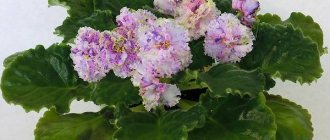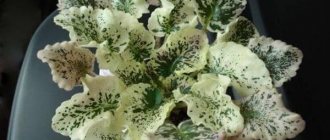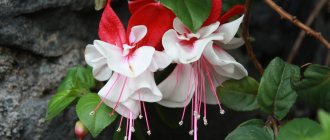The world of violets is very colorful and amazing. A special class is varietal Saintpaulias, the care of which requires some knowledge.
Breeders are creating more and more new species, but only a few deserve recognition among collectors. This article is dedicated to the PT-Foxtrot . Here you will find detailed photos and descriptions of the variety and learn about the features of growing it at home.
Violet PT-Foxtrot (T. Pugacheva)
Breeder from Kursk Tatyana Pugacheva has been doing what she loves for many years. Breeding a new variety of violet is not easy - pollination, germination, testing of varietal characteristics. PT-Foxtrot was created in 2015 , and already in 2016 it was rapidly spreading among collectors.
Large star-shaped flowers are decorated with pink and white fantasy in the form of streams and strokes . The leaves are dark green and the flower stalks are quite large and hold large flowers.
A fairly sporty variety - in almost 30 percent of cases it thrives in a different way.
Features of flowering, growth and reproduction
Violet babies:
- Grow quickly;
- And they form perfectly under normal conditions.
Typically, it takes no more than a year to obtain an adult, and the first flowering occurs earlier.
The first flowering rarely corresponds to the description ; the flowers are usually small, often not double and may differ in color from the original.
From the second flowering onwards, the flowers take on a corresponding appearance. The flowers are large, double, and usually bloom in caps. Peduncles:
- Sturdy;
- Short;
- They support heavy flowers well.
Depending on the temperature, the color of flowers can change quite dramatically . In hot weather, flowers can be:
- Completely dark;
- Or have small white borders.
In cool conditions, the amount of white can increase greatly , sometimes the crimson spots become very small and rare, or disappear altogether.
Important! The flowers do not last very long, up to a week. But the number of buds laid ensures long-term flowering.
Saintpaulia can be propagated from leaf cuttings.
All available methods are suitable for propagation . The absence of variegation on the leaves removes the restriction on propagation by peduncles. The non-chimeric color of the flowers allows it to be propagated by leaves. And for pinching, the only limitation can be their poor formation in this variety.
Features of care
So, in the case of varietal violets, it is important to know certain care rules . Having created the necessary conditions, you can regularly admire the lush head of flowers.
Soil selection
The most important point is the composition of the soil . Saintpaulias do not tolerate heavy substrates - the root system begins to rot in them.
The best option is high-moor peat with perlite or foam balls in a ratio of 70 to 30 . Vermiculite, contrary to advice on forums, does not need to be added - it has a moisture-retaining property, which can lead to rotting.
If we are talking about wick irrigation, the ratio of peat and ripper changes to 50 to 40, respectively.
Lighting
This particular variety does not tolerate a lack of light . In conditions of insufficient lighting, PT-Foxtrot begins to stretch out the leaves, the flowers become smaller or their number becomes negligible.
The variety is suitable for shelving or for a south-eastern window sill. In this case, direct sunlight should not fall on the plant, otherwise dry spots may appear.
Watering
Watering is done very carefully:
- as soon as the soil dries 1 centimeter, you can carefully spill the container with a small amount of water;
- if the plant is a little dry, add water in small portions, literally drop by drop;
- If the violet is flooded, it is necessary to urgently change the soil.
You can see problems with watering by drooping leaves or darkened cuttings.
Air humidity
As for humidity, only excessive dryness harms the flower . If dry spots or cracks begin to appear on the leaves, you should place a jug of water or a humidifier nearby.
To increase humidity, use a tray with wet expanded clay.
Top dressing
Fertilizer is applied strictly according to the instructions on the package ; it is advisable not to overfeed Saintpaulia with nitrogen fertilizers - in this case, you may not get flowers.
Content temperature
The variety does not tolerate heat well - the flowers become smaller, the fancy pattern practically disappears. The optimal temperature is from 15 to 22 degrees.
Plant hygiene
Every violet should be washed periodically. Yes, yes, Saintpaulia responds well to bathing! It is only important not to fill the soil and leave the flower in a dark place without drafts until it dries completely. Carefully rinse each leaf under running water, slightly tilting the violet.
Important! When pests appear, such as ticks or scale insects, it is best to use industrial products - they are much more effective than traditional methods. After applying chemicals, the violet will need to be washed!
Violet LE-Natalie
Saintpaulia "LE-Natalie" of the most delicate shades is the result of breeding developments by Vinnitsa master Elena Anatolyevna Lebetskaya.
Description
In varietal violets, the rosette of medium diameter is described as standard.
ATTENTION! The main feature of Saintpaulia "LE-Natalie" is the formation of a magnificent exhibition leaf rosette with aligned contours and a symmetrical configuration.
Violet leaves have an oval-heart-shaped shape, a wavy edge with notched serrations and a summer green tone with light green venation of clear extrusion.
Photo of violet LE-Natalie.
Saintpaulia blooms in a cap type without rest throughout the growing season.
The white corolla stars of considerable size are distinguished by semi-double fullness, corrugated edges of the petals and fantasy strokes and spots of pinkish-lilac chaotically scattered throughout the flower.
Sports
From the violet “LE-Natalie” came the officially recognized sport “ND-Natalochka” (selection by N. Deryabina). It is distinguished by corollas of a blue tone with chimeric strokes of white and a fringed edge of the petals.
Features of maintenance and care
Violet belongs to the problem-free varieties:
- is not capricious about leaving;
- forms an exhibition rosette;
- blooms profusely and for a long time;
- has strong peduncles that ensure the erect position of the buds.
A nuance when keeping violets is the dependence of the color of the corollas on light and temperature:
- in strong lighting, the brightness of fantasy is lost;
- high temperatures enhance the intensity of fantasy coloring.
Reviews
Sofya Andreevna. “The violet “LE-Natalie” is my favorite. Her chic rosette has made me a prize-winner at exhibitions more than once.”
Natalia Lvovna. “I adore my namesake – Saintpaulia “LE-Natalie”. My husband gave it to me for my birthday. I take care of my beauty and admire the delicate fantasy drawings.”
Transplantation and rejuvenation
After flowering or if the plant ages, it needs to be replanted. The pot should be small; violets grow well in 100 ml plastic cups. For beauty, it can be placed in a flowerpot.
So, a regular transplant only involves replacing the soil. But the bare trunk needs to be cut from the bottom , like a carrot, stripping the trunk to the green base. The lower leaves need to be torn off.
After this, the plant is planted in light soil, but it is important not to bury the growing point too deep. If leaf turgor is lost, it is better to place the plant in a greenhouse.
If you decide to keep your violet on wick irrigation , then the composition of the soil also changes - 40 to 60 peat and cultivators. Make sure that the plant was planted on a small hill. You cannot use threads made from natural materials - they will rot.
Breeder Evgeny Arkhipov: brief information
He began his career as a breeder in 1999. Already this year pollination occurred, which resulted in the appearance of new species:
- "Sea Myth".
- "Charming."
- "Evening Stars".
The breeder himself considers these varieties a strategic mistake, since these varieties had simple, non-double star-shaped flowers or fancy pansies, although they had good data on the quality of peduncles and the abundance of flowering.
Since 2006, there has been a qualitative breakthrough - varieties with unique colors have appeared , which still have no analogues. For example:
- "Armageddon".
- "Vesuvius Elite"
- "Sagittarius Elite".
- "Cupid" and so on.
Reproduction
How to propagate violets? There are several ways - with a leaf or a stepson.
In the first case, you need a healthy cutting from the middle row . Never take leaves that are too small or too large! The cutting is cut at an angle of 45 degrees with a sharp blade and then placed in a plastic cup with soil. There is another way - wait for rooting in water.
As practice shows, the method with earth ends successfully in 90 percent of cases . The main thing is not to flood the soil.
After planting, the leaf is watered from a pipette and placed in a greenhouse. Enough lighting and warmth - within a couple of weeks the leaf will take root, and in a month or two it will produce babies.
The stepchildren are simply separated from the mother plant and also planted in light soil. It can take up to 10 months from planting the cutting to the first flowering.
Stepson.
IMPORTANT! The PT-Foxtrot variety is a rather slow-developing variety.
Violet RS-Natalie
An excellent variety obtained by breeder Svetlana Nikolaevna Repkina from Lugansk.
Description
The violet forms a leveled rosette with fairly symmetrical contours. Based on the average size of the bush, the variety belongs to the standard type.
The leaf blades are round in shape and have a dark green tone with slightly lighter veins, a shiny, slightly pimply surface structure and a wavy-jagged edge on the side edge.
Photo of violet RS-Natalie.
Flowering occurs in bouquet type. The bush forms heavy, large-diameter corollas of terry fullness, colored with tints of delicate shades of pinkish tones. Small splashes of soft raspberry color are visible along the contour of each petal.
The volume of the flowers is added by a lush fringed border along the edges of the petals.
Sports
From time to time, violet forms sporty specimens, characterized by the absence of dusting on the petals.
Features of maintenance and care
Saintpaulia does not cause trouble to the gardeners who grow it , it grows easily, forms a rosette of the correct outline, blooms quite luxuriantly due to the size of the corollas and retains a decorative appearance for a long time.
A nuance when maintaining the variety is the long preparation for flowering.
ADVICE! In the process of forming a rosette, leaf plates of the “RS-Natalie” variety can be tucked down towards the flowerpot in case of minor violations of the regime. In this case, you can use a rosette corset to form a decorative bush.
Reviews
Arkady Valentinovich. “I have been growing Saintpaulia “RS-Natalie” for several years. If you follow all standard care methods, it grows and blooms magnificently. The only problem is that when propagated by leaf cuttings, sports sometimes appear.”
Margot. “The violet “RS-Natalie” resembles a smaller version of a bouquet of roses.”
Features of development
As mentioned above, PT-Foxtrot is a fairly sporty variety. Moreover, collectors note that changes in varietal characteristics sometimes do not depend on environmental conditions.
During the period of bud formation, it is ideal to create a temperature difference for the flower. For example, place the plant on a warm balcony at night or periodically turn on the air conditioner.
Another important feature is the fairly spreading outlet. It is important to focus on potash fertilizers for full flowering . A large amount of nitrogen leads to lengthening of cuttings and enlargement of leaves.
The PT-Foxtrot has a fairly spreading rosette.
If, after all, the plant begins to bloom not according to its variety, do not be discouraged - such flowers are no less beautiful.
Display of vital phases
All vital processes of varietal violets proceed according to the most undemanding option , coinciding in general terms with the classic growth of tropical beauties in indoor collections.
There are only minor nuances of the content , which in no way will prevent even a beginner - an amateur - from caring for specimens of the variety.
Specificity of room development
According to the author's idea, the variety is one of the most problem-free violets , which are not capable of causing any problems, but are intended to provide only aesthetic pleasure to the flower growers who grow them.
Among the obvious positive characteristics of the variety, the following can be noted:
- Easy adaptation of violets to the microclimate conditions provided to them;
- Positive response to even the most simple care, expressed in rapid growth;
- Independent formation of a rosette, distinguished by the correctness of its shape;
- Lush flowering with an abundance of developing buds;
- Duration of the period of preservation of decorative freshness of flowers.
For all its positive qualities, the variety has a rather unpleasant defect - its flowers turned out to be overly dependent on changes in temperature indicators.
Slightly lower temperatures are accompanied by the blooming of flowers in intensely bright colors , in turn, an increase in temperature indicators leads to a strong lightening of the tonality of the corollas.
Violet also has other, but completely minor, disadvantages in development, which can:
- Eliminate on their own - long petioles on young leaves, giving the rosette a loose structure in the initial phases of its growth,
- Do not particularly disturb the decorative effect of the plant - folding leaf plates.
ADVICE! When placing flowerpots with violets on window sills, the plants should be especially protected from drafts!
Growth to adult stage
According to botanical laws, Saintpaulia is considered to have reached adulthood at the moment when it is ready to lay the first flower buds .
Since all the life phases of the variety correspond to the standard development patterns of the genus, the period of violet maturation will end approximately eight months after the appearance of small children on the leaf cuttings.
The process may take slightly less time provided:
- Formation of an adult plant from a shoot separated from the mother violet;
- And rooting it in its own flowerpot.
The bush will only have to increase its leaf mass until the flowering phase .
Peculiarity of reproduction
Obtaining young bushes of varietal violets in home collections can proceed according to two scenarios:
- Forming several children on a leaf taken for cuttings and planting them in flowerpots of appropriate sizes after the appearance of their own roots and sufficient green mass;
- Separation of the stepsons grown on it from the mother bush and their subsequent rooting in their own flowerpots.
The seed propagation method is completely inapplicable to varietal violets - according to experts, supported by practical experiments, this is fraught with a complete loss of the original characteristics of the variety.
And the process of violet rejuvenation, regularly used by flower growers to improve the health of older specimens, completely preserves the varietal characteristics .
Effect of temperature on flowers
Varietal violet is distinguished by a strong degree of temperature dependence:
- Hot weather during the violet flowering period means the blooming of flowers with a pale color scheme;
- Low temperatures cause the appearance of bright, saturated shades in the color of flowers.
The structure of peduncle branches
From the very first flowering, the variety produces flower stalks:
- Strong;
- Robust structure with slightly shortened length.
This helps them:
- Maintain flowers in an upright position;
- And promotes the formation of cap flowering.
Flowering style model
Experienced flower growers recommend interrupting the first violet flowering, which takes place on a rather modest scale, at the stage of unopened buds .
This will allow the rosette to accumulate additional strength for the next flowering, which will already be able to give a cap version of the volumetric masses of flowers.
Lifespan of an individual flower
Saintpaulia blooms for up to three months.
Each stage of violet flowering can last up to three months in a row , but maintaining the decorative and fresh state of each flower in a varietal violet can last for a long time - more than a month.
Reviews
Natalia. “Foxtrot was given to me by a friend on the violet growers forum, in the form of her stepson. I don’t bother too much and plant all the violets in purchased soil, adding a little perlite. The plant began to bloom within a couple of months, growing by leaps and bounds. But alas, I ended up with sports. I’m growing a new specimen from a different leaf.”
Catherine. “Personally, the variety seemed very problematic to me. Sometimes the leaves stretch out, sometimes the flowers are small, sometimes they thrive in sports. Apparently, my conditions did not suit him. I gave it to a friend, she blooms tirelessly.”
Elena. “I really liked Foxtrot. Surprisingly, it grows on a window, without additional lighting, without any problems. I generally don’t like capricious varieties, I get rid of them quickly.”
Marina. “I received this violet as a gift with my order. Since the colors did not inspire me at all, I simply planted the leaf in the ground, without any greenhouses. Imagine my surprise when Foxtrot gave birth to babies before anyone else! I currently have 2 plants grown from the same leaf. But they bloom differently - one bush is white, and the other is a varietal one.”
Antonina. “I didn’t like the violet - the flowers most often do not have a fancy color, the cuttings are elongated. I couldn’t determine the optimal watering - I constantly dried it out, then flooded it, while trying different frequencies and amounts of water. I gave it to a friend."
Violet Deo-Natalie
An extraordinary variety was created by Moscow breeder Olga Nikolaevna Aksenkina in 2009.
Description
Saintpaulia forms rosettes of considerable size , passing along the upper numerical limit of the standard type. The bushes have a neat configuration and a leveled contour.
The oval-shaped leaf blades are distinguished by a dark green tone with swampy reflections, a matte surface structure and a smooth, slightly wavy edge.
Photo of violet Deo-Natalie.
Produces large-diameter corollas of terry and semi-double fullness. Petals with wavy edges are arranged in neat tiers on top of each other.
The flowers are colored in transitions of deep pink tones with frequent veins of more intense shades, directed from the center to the edge. The underside of the petals has a whitish color with a matte structure.
Sports
No sports were observed in varietal specimens
Features of maintenance and care
The variety is suitable for keeping in the collections of flower growers with any experience with Saintpaulias:
- is not picky when leaving;
- blooms magnificently and for a long time the first time;
- has a very decorative appearance.
An unpleasant nuance is that the rosette occasionally tries to pull the leaves up.
NOTABLE! The variety “Deo-Natalie” simultaneously forms a large number of buds that bloom in large corollas. To preserve the health and decorative appearance of the bushes, it is recommended to sometimes remove some of the flowers that have not yet bloomed.
Reviews
Igor Pavlovich. “I’ve been collecting a collection of Saintpaulias with women’s names for a long time. The “Deo-Natalie” variety captivated us with its lush, unusually shaped flowers with a white lining. I am very pleased with the purchase of the violet.”
Dinara Renatovna. “Of the Saintpaulia group “Natalie,” I like the variety “Deo-Natalie” the most - wonderful buds of original color.”











